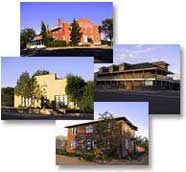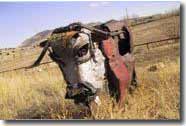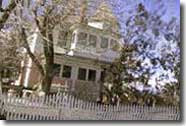
Magdalena and the surrounding region exhibits a rich history ranging from the mysterious Ancient Ones, the Anasazi, to the more recent miners and cowboys of old Magdalena. Relive history as you walk back in time at places where evidence of their passing still exists.
 Village History
Village History
For over 1,000 years the area surrounding present day Magdalena has been home to Native Americans, then in the late 1500s, the Spanish, and over the next 400 years fur trappers, soldiers, ranchers, and miners, hearty people whose children continue to build their future here today.
Magdalena was once a bustling railhead which supplied the substantial mining and ranching industries in the area. The town was established in 1884 and reached a peak just before 1920. Today it is an interesting, appealing village with a few commercial buildings and a number of fine houses representing its wealthier past.
The Village of Magdalena is significant because it was once west central New Mexico's most important commercial center. Located at the end of a spur line from Socorro, miners from the lead, zinc, and silver rich district shipped their ore out and ranchers throughout western New Mexico and eastern Arizona drove their cattle here. The miners and ranchers bought their supplies from the many mercantile establishments in Magdalena and stayed at the several hotels that were here. During its most prosperous years, 1884-1925, many fine buildings and houses were built in Magdalena.
As such an important shipping center, Magdalena supported many commercial establishments. These buildings were generally hastily erected from wood and adobe, often with false fronts. In 1886 Magdalena supported two general stores, one notion store, one drug store, two livery stables, 3 restaurants, two blacksmith shops, two lumber yards, one hardware store, one sash and door outlet, one bookstore, one feed store, one church, one school, and four saloons. At about that time there were 12 to 15 houses and one hotel. In a few cases, as businesses prospered and fire took its toll, the wood and adobe buildings were replaced by more substantial stone and brick structures.
Magdalena has become popular once again, as have many small towns across the country. Its endless vistas, clear air, and natural surrounding beauty is very attractive to artists, writers and others seeking a quiet life away from the bustling cities. Some of the older historic homes are being sensitively remodeled and many fine homes have been built in the surrounding areas. Once again the population is growing. New businesses are being established, along with a thriving artist's community.
 Badger/Bruner Warehouse
Badger/Bruner Warehouse
North Main Street

Warehouse 1-10, a contemporary art space and private residence was known as the "Badger / Bruner Warehouse", built in the early 1900's to store hay. It also housed the local mail and at one time a Forest Ranger Office as well as the former Magdalena Feed Company. The original adobe portion of the building dates from the late 1800's - with the outer steel added much later in the 1900's.
 Wool Warehouse
Wool Warehouse
North Main Street

The railroad tracks were on the north side of this old warehouse building. Built out of wood, with a corrugated metal roof, it somehow defied the fires that destroyed other buildings on the block. At one time it had a wagon high wooden loading dock now covered by concrete. It was used to store wool and hides that ranchers and trappers would bring into town for shipping east. If wool and hide prices were low the ranchers would leave their wool at the warehouse until prices rose.
This building was typical of the wooden structures of the era. It was built in 1913 and, like many of Magdalena's structures, has had many roles to play. It now serves, fittingly, as an antiques store. The front floor is the original ball room floor from the first Hilton Hotel in Socorro.
 Ilfeld Warehouse
Ilfeld Warehouse
North Main Street

Built in 1913 in the Mission Revival Style, this red brick, gable roofed building is in excellent condition. One of its most remarkable features is the hip roof pavilion at the center. In 1916 the building became a part of the large mercantile firm of Charles Ilfeld, one of the largest mercantile companies in New Mexico.
Ilfeld began his career in Las Vegas during the 1870's. He supplied general merchandise at the wholesale level to smaller outlets and at retail level in his store. The business expanded to many towns across the State. Magdalena was a central warehouse serving ranchers and small businesses in southwestern New Mexico and eastern Arizona. Mercantile outlets such Ilfeld's were essential to ranchers because they were allowed to buy supplies against receipts from the sale of cattle and sheep each year.
In 1959 the grocery warehouse division of the Ilfeld Company, including the Magdalena Warehouse, was sold to Kimball Foods. Some years later it was sold to its current owners. The building is on both the State and National Register of Historic Buildings.
 Rodeo Grounds
Rodeo Grounds
North end of town

It has been argued by former Mayor Clayton Hust that the first rodeo in the United States was held in Magdalena. Certainly Magdalena was the scene of much rodeo history. People would often travel for days to attend.
Many of the old time rodeo performers appeared here: Hugh Strickland, Mable Strickland, Milt Hinkle, Leonard Stroud, Wayne Stroud, Cheyenne Kaiser, Montana Bill, Tex Parker, and Mildred Douglas. There were several quite capable lady bronc and bull riders as well as daredevil men. But in 1912 the real star of the Rodeo was the famous bucking horse "Dun Gon." Dun Gon was next to impossible to ride. He had a strange way of bucking a few jumps, then he would rear up and go into spins.
Magdalena match races were gambling events and races were held at the rodeo grounds. Although racing was not big business in Magdalena, plenty of money changed hands.
 Santa Fe Depot
Santa Fe Depot
North Main Street

This fine example of a railroad building is listed on the National Register and serves as the Village Hall and Library. It was built in 1915 and is Santa Fe Railroad's Standard Frame Depot #3. Along the north side of the depot was a large loading dock. The last run for the line was November 20, 1973.
The building was purchased by the Village in 1974 to serve as its offices. The Box Car Museum is next to the depot on the north side and is open to the public.
 Commercial Building
Commercial Building
North Main Street

A fine example of the Panel Brick Style, with the brick facade applied to an adobe building. It first appears on maps in 1919. It is a good example of a commercial building typical in Magdalena. With few exceptions, buildings in Magdalena were constructed of wood or adobe, both considered inexpensive, impermanent materials.
Magdalena has lost many buildings through deterioration, fire and demolition. Well maintained, intact buildings such as this one stand out.
 Bank of Magdalena
Bank of Magdalena
US 60 & Main Street

The corner portion of this brick building was built prior to 1908 and was added onto by 1913. This commercial building is noteworthy as one of the few commercial buildings to be constructed of material other than wood. Notice the ornamental brickwork in the arches and along the cornice of the parapets. This building has been a bank, a drug store and now houses Evett's, a cafe and ice cream shop.
 Salome's Store & Warehouse
Salome's Store & Warehouse
US 60

The Salome family has been in the general merchandise business in Magdalena for many years. The Salome brothers, George and Joe, established the store in 1910, and built the present Salome Store building in 1911. Noteworthy, even today, are the fixtures in the store. The wide cash counter, the antique bench to sit on while trying on boots and shoes, and the protective glass enclosed wedding gown cabinet are still inside the building.
 Old Jail House
Old Jail House
Second Street & Elm

Once the jail for the rowdies of Magdalena. It is small and would become quite crowded when the cowboys were in town with the cattle. They would get drunk at one of the many bars of those years, and it wouldn't be long until the fistfights – and sometimes gunfights – flared up. The sheriff would round them up and let them enjoy an evening in this quaint building. Now it stands as a remembrance of wilder days.
 MacTavish House
MacTavish House
Third Street & Oak

Started in 1909, this large home was designed to accommodate the MacTavish family and their many guests. The five bedrooms and large closets welcomed travelers arriving by train and wagon.
The Queen Anne styled home was finished in 1910 and contained many beautiful furnishings from "back east." One of its features is a coal bin large enough to hold a railcar load of anthracite coal ordered in from Pennsylvania every year.
The MacTavish family lived in the home until 1940.
 MacTavish/Blackburn House
MacTavish/Blackburn House
Third Street & Oak

Possibly the oldest surviving house in town. It was built before 1887. John S. MacTavish bought it in the late 1890s. The MacTavish family occupied this house until their new home next door was ready.
 Old WPA Gym
Old WPA Gym
South Main Street

This WPA building was erected in 1936 on the original site of the rock school building. The rock building was so sturdy that the workers were unable to tear down all the walls. It is said part of the original school building makes up the walls of the WPA gymnasium. This building had the only stage in town and was used for plays as well as many a graduating class ceremonies.
 Roosevelt School
Roosevelt School
South Main Street

Built with bond issue money, the school was completed in 1919. Few changes have been made on the facades with the exception of the removal of the California mission-style stucco domes. The building, now privately owned, is used for artists' studios and art fairs, and has residential apartments as well.
 Hays House
Hays House
Second Street & Spruce

This two story brick structure has had many different uses. It has seen life as Dr. McCreary's offices and hospital. Dr. McCreary stayed in Magdalena from 1907 until the late 1920's. The Forest Service was once in this building, after which it was partitioned into small apartments. At a later period it was used as a single family home.
The oddity of this house is that the upstairs could only be reached by an outside staircase – interior stairs have only recently been added.
 Magdalena Hall Hotel
Magdalena Hall Hotel
Second Street & Spruce

Today the old Hall Hotel is known as the Magdalena Hall Hotel. It is the only hotel structure which remains from the several large hotels in Magdalena. The exterior walls are three bricks thick. Two inside layers are of local brick; the facing brick was imported. The three-story Hall Hotel with its second-story balcony was officially opened December 14, 1917. Many rich and interesting legends have originated at this landmark hotel and are often told and retold by the locals.
The time-worn hotel has sprung into a new life. It has been extensively remodeled from top to bottom. This newer version is being used for housing and retail. The history of yesteryear was considered from every coat of paint to the beautiful old windows, as well as the lovely railings around the second-story balcony. It was finished in 1999 and is now occupied.
 Magnolia Cafe
Magnolia Cafe
US 60

Once the Magnolia Gas Station, this building now is used as a restaurant. Behind the original gas station was a campground with cottages used to accommodate the tourists that came to the area. The building's diagonal doorway and wood floors are reminiscent of time gone.
 Mrs. Butterfield's Lying-in Hospital
Mrs. Butterfield's Lying-in Hospital

The hospital is today The Western Motel on Hwy 60. "Grandma Butter" was a legend in her own time. She ran the lying-in hospital with very little help, sometimes working all shifts in one day. Often mothers who had their babies would stay over for a period of weeks to help with patient care and work off their expenses. A hospital room, food, and care cost $5.00 a day. Delivery fees were $25.00.
 The House on the Hill
The House on the Hill
US 60, east of town

The house on the knoll at the east side of Magdalena was built around 1909 by Joe Hilton, cousin to Conrad Hilton of Hilton Hotel fame. The knoll is a natural hill of almost solid rock and was used as a rock quarry prior to Hilton buying the land. Many of Magdalena homes have foundations from that site. Before Hilton built the house he blasted off rock to build the inside and basement walls. This home was two levels when first built. The second floor was not reconstructed after it was damaged by fire.
All photographs © Rolf Magener. Not to be used without permission of the photographer.





